Photo Essay: CFSC in the Republic of Maldives: A Community in Transition by Jean Douglas-Laird
The Republic of Maldives, an Asian country near the southern tip of India, is the world’s smallest, predominantly Muslim nation. The country spreads across 1,196 coral islands grouped in a chain of 26 atolls. Only 200 of the islands are inhabited. Male, the capital, is densely populated—120,000 people live on an island of less than two square kilometres. Fifty percent of the people are 25 years old or younger.
Many residents say their traditional culture is disappearing.
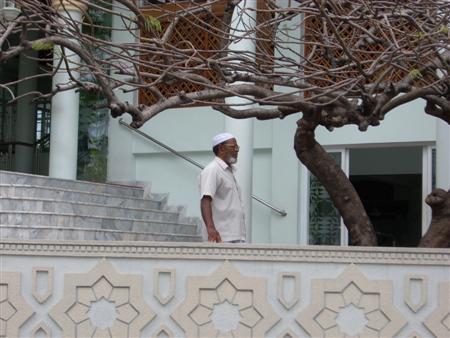
Fewer people attend mosques.

Family fishing is dying out.
Young people have few options, in terms of employment and recreational facilities.


The nation’s elderly, many poor and without formal education, work hard to survive.
Nature also poses problems. The 2004 Tsunami here was not localised, as in other countries. It washed over the Maldives with devastating effects.

The Tsunami swept over concrete tetra pods, built to protect Male from the sea.
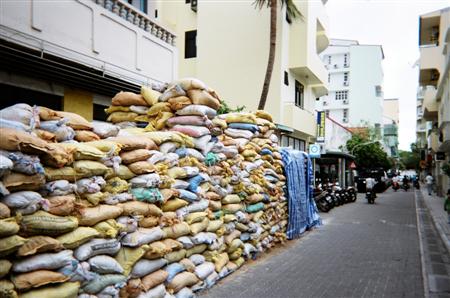
As a result, sandbags are a typical sight around Male.
With so little available space the only way to build is up. Unfortunately, many people cannot afford to live in these modern buildings. Families of 10-15 often live in two small rooms.
From August 2005 through July 2007, Douglas-Laird worked in Male as a VSO volunteer. VSO is an independent, international development organisation that works through volunteers to fight poverty in developing countries.
As part of her master’s candidacy in theatre for development at the University of Winchester, Douglas-Laird returned to Male in January 2008 for a four-month stay. She worked with two local NGOs, facilitating workshops in participatory video, drama and photography.
She worked with Journey, a drop-in centre for former heroin addicts offering support and peer education programmes, and Society for Women against Drugs (SWAD), which supports families and friends of addicts through counselling and awareness campaigns.
Through workshops and one-on-one dialogues with participants of the two organisations, Douglas-Laird gained a rare insight into local community challenges. While many people cited overcrowding and lack of care for the elderly as serious challenges, the overwhelming majority identified drug abuse as spiralling out of control and in need of immediate attention.
In fact, illegal drugs are a serious problem in the Maldives. According to a 2006 report, every family in the country is affected by drug abuse. Local estimates suggest that 20,000 to 40,000 people countrywide are addicted to heroin, with most of these living in Male. The stigma of drug abuse has made it difficult for people to discuss the problem together and try to find solutions.
As an effort to bring the drug problem and other social concerns into the open and, thereby, stimulate open community dialogue regarding possible solutions, Douglas-Laird gave her workshop participants disposable cameras. She challenged them to take pictures of the real Maldives—pictures reflecting issues they discussed in the workshops.
The photographs—shown throughout this essay—show a society in transition. They a part of an exhibition that took place in May 2008, at a popular Male café /restaurant. The opening was well attended, including people from UNICEF, the National Narcotic Control Bureau, other NGOs and a Maldivian TV crew.
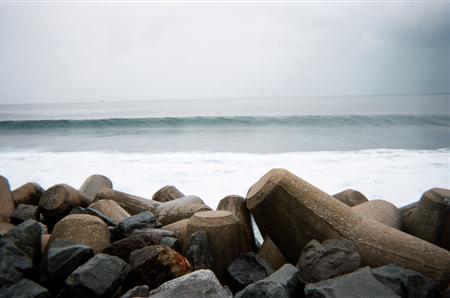
The young man who photographed the tetra pods saw them as a symbol of the silence of a society in fear. As the tetra pods failed to stop the Tsunami, so silence cannot stop the scourge of drugs.

Young people use heroin on this stairway.

Drugs and money change hands. “Beware,” warn the workshop participants, “Drugs will cost you more than money.”
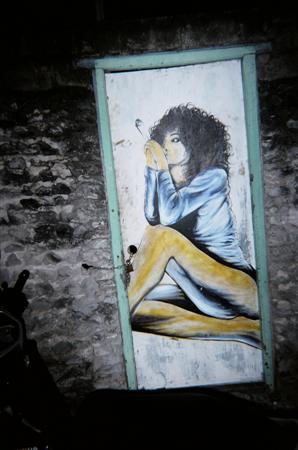
Of this image of a young heroin addict, the photographer cautions, “Appearances can be deceptive. Don’t let her lead you astray!”
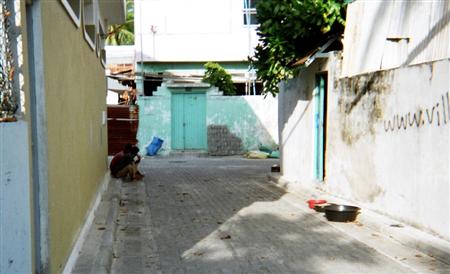
The boys sitting in the street are actually using heroin.

The future of the Maldives lies in the hands of innocent children.
Why the Maldives are Vulnerable to an HIV/AIDS Epidemic by Jean Douglas-Laird
This article is the result of the author’s experience working in the Maldives between 2005 and 2008, initially as a volunteer in the international development organisation VSO, in the Faculty of Education, based in Male, and for an additional four months as a volunteer and Theatre for Development facilitator.
Overcrowding and unemployment
The Republic of Maldives is a South Asian country in the Indian Ocean, consisting of 1196 coral islands, 200 of which are inhabited. A United Nations study in 2000 revealed that in the smaller islands, 55 percent of the population had no radio and 86 percent had no access to television.
Lack of cultivable land has restricted agriculture potential, with the notable exception of coconut harvesting. Most food has to be imported to the country.
On most of these atolls, the widely disbursed population poses logistical problems for HIV/AIDS educators.
In the capital island of Male, density of population—Male is one of the most densely populated places in the world—contributes to the spread of HIV/AIDS. With a high population growth rate and almost 50 percent of the people under age 25, there is an acute shortage of jobs. Between 2000 and 2006, the unemployment rate in the country increased significantly from two percent to 14 percent. (
Housing is at a premium in Male; rental rates have soared until they are on a par with European rates. As a result, many people share accommodations; It is not uncommon for 7 to 10 people to share one room.
Families from the outer atolls who want their children to benefit from the higher educational standard in Male schools, often send their children as a group—with a Male-based relative in charge of them—and share the cost of a one bedroom apartment between families. These conditions create stress and often lead to risky behaviour, especially if supervision of these vulnerable young people is minimal.
Socio-economic factors
Changes in the country’s economic structure have, in a sense, begun to undermine the social stability of the Maldives, making a considerable impact on the vulnerability of the Maldives to HIV.
The Maldive’s fishing industry, a key source of foreign exchange earnings, has long been the traditional way of life for Maldivian people. Today, fishing provides employment for approximately 10,000 people. Government licenses permit holders to catch 40,000 metric tonnes of tuna per annum in exchange for 10 percent royalty.
Mechanisation of the fishing industry in 1970, coinciding with the advent of tourism, has contributed to rapid economic growth in the country. Now, tourism is 33 percent of GDP and is the largest source of foreign exchange earnings. About 90 percent of the government’s revenues originate from import duties and taxes from the tourist sector.
The ever increasing rise in tourism over the last three decades has been impressive, with 88 resorts operating by 2006. The relative successes of these two industries—fishing and tourism—are related and, while appearing as positive indicators of economic growth, this very success is unravelling the social fabric of the country.
The mechanisation of the fishing industry caused a substantial loss of jobs in the industry, forcing many Maldivian breadwinners into the tourist sector. Together with tourism, this restructuring has had a profound impact on the lives of the Maldivian people and created huge rifts in social norms and ways of life.
First of all, many of those surplus workers had to leave their islands and their families to work on resorts. Resort workers typically spend long periods—four to eight months—away from their families, leaving their wives behind to manage the home and children on their own. The impact of an almost “mass absence” of a male role model on some of these islands cannot be ignored.
For example, Addu atoll, where high numbers of males have left for jobs elsewhere, has experienced serious social concerns, such as discipline problems in schools, violence, crime and an alarmingly high incidence of drug abuse among young people.
Young people on the islands have little or no opportunity for employment, creative or leisure pursuits. Heroin, however, is easily available. For an increasing number, heroin offers an escape from a world seemingly without a future. In addition, the isolation of resort workers, both migrant and local, can often lead to sexual behaviour that carries a high risk of HIV infection.
Prevalence of HIV/AIDS
The first case of HIV positive in the Maldives was reported in 1991, and, until 2006, a total of 13 HIV positive cases were reported among Maldivians and 168 among expatriates. Despite the high level of drug use, especially by needle, a Ministry of Health situational analysis on HIV/AIDS in the Maldives, 2006, reported no reports of syringe or needle-related transmission.
A UNFPA reproductive health survey in 2004 revealed a 99 percent level of awareness of HIV/AIDS among the sample; 91 percent knew of at least one way of HIV transmission. However, 69 percent of those who responded believed “respecting religious tradition” was an effective way to prevent HIV.
Although this could be interpreted as monogamy and/or abstinence, this was not apparent from the survey. Only 50 percent agreed that condoms could protect against HIV and 34 percent were unaware that a healthy-looking person could have HIV.
While recent reports reveal relatively low levels of HIV in the Maldives in comparison to neighbouring India and some other Asian countries, the government cannot afford to be complacent in the face of the current drug-abuse situation which, as we shall see, has recently been spiralling out of control. Neither can it afford to ignore the issue of blood safety which will be discussed in the next section.
Thalassemia
The Maldives has the highest prevalence of Thalassemia in the world with a carrier rate of 18 percent of the population. For many thalassemia major, the situation is serious—the mean average life span is 25 years. Sufferers cannot make enough haemoglobin and are, therefore, in constant need of blood transfusions throughout life.
The National Thalassemia Centre carries out regular screening for carrier status among all seeking to marry and offers medical termination of pregnancy to couples who are both carriers. Even so, the illness, while in decline, remains prevalent today,.
Another worrying concern is that the sector of society involved—either as recipients or providers of transfusion services—would be those under 35 years old. In 2000, 48.7 percent of the population were 17 years old or younger, and 27.5 percent were between the ages of 18 to 35
The sharp increase in the number of young drug users, and especially those injecting drugs, is cause for concern. It raises issues of HIV/AIDS blood safety. Moreover, all transfused blood cannot undergo a PCR-trace lab investigation.
Sexual practices
Maldives has the highest divorce rate in the world, 10.97 per 1000 people Re-marriage rates are also high. Sexual relations are only “legal” within the context of marriage, and consequently, people get married quickly and divorce often. Furthermore, divorce—and divorced women—are not stigmatized in Maldivian society.
Although the age of first marriage seems to be increasing, most couples are sexually active before, or without, getting married. A high proportion of divorced couples remarry so that women often end up having three or four marriages to two or three men over their life-time.
Being a Muslim country, Shari’a law allows men to have four wives. In reality, however, most Maldivian men are serial monogamists. While this may be preferable for the current wife in favour, it nevertheless creates complex family units where children often live with many half-sisters and brothers and new partners of their parents.
Similar marriage patterns have been noted among island societies in the Pacific, and may be related to constrictions of atoll life and matrilineal social structures, which predated patrilineal social structures currently in place. (Jenkins 2000:9)
Today, however, such high rates of divorce and remarriage are highly significant in terms of exposure to large sexual networks capable of transmitting HIV and other STIs. Since symptoms of HIV infection often do not appear for many years, people who are unaware that they are infected may infect their serial spouses and casual sex partners.
An additional factor contributing to the vulnerability of young people to HIV is the high level of sexual awareness among youth in the Maldives.
A Rapid Situation Assessment 2003 survey reported the age of first sexual experience to range from 7 to 24 years. One third of those surveyed had been exposed to a sexual experience by age 15 and 92 percent having had a sexual experience during their teenage years. More than one in four respondents reported having sex with a commercial sex worker. Drug use with a member of the opposite sex was common (65 percent) and usually in the context of a relationship. Less than 30 percent reported consistent condom use.
Given that almost 50 percent of the population is under age 25, the high level of sexual awareness among these young people, as well as the patterns of sexual behaviour, it is clear that there is great cause for concern in terms of a potential HIV/AIDS epidemic. If we add to this the increasing numbers of injecting drug users, we see the magnitude of the threat.
Drug use
Drug abuse is on the increase in the country, particularly on Male and Aduu atoll. Heroin is available everywhere, even in the most remote island communities. In the outer atolls, reports of inhalants, cologne and alcohol are also common. Two local NGOs with direct involvement in drug awareness education and rehabilitation, SWAD and Journey, believe there are close to 30,000 users, with an increasing proportion injecting and with many beginning use by ages 9 to 12. Unemployed young people are the most vulnerable group.
The market for illegal drugs is worth approximately two million Rufiyaa (US$157,000) a day and US$57,305,000 annually, more than five percent of the Maldives’ entire US$1bn legitimate economy. Opioids, primarily brown sugar, hashish oil and other cannabinoids are the most frequently abused drugs. In the Maldives, as all over South Asia, the abuse of heroin and pharmaceutical preparations by injection is among the main factors contributing to the spread of HIV/AIDS.
Drug use is a high risk factor for HIV infection for two reasons: drug users who cannot afford their doses may resort to selling sex to earn money for supply, and injecting drug users may share contaminated needles. At the time of writing, there is no needle exchange programme in the Maldives.
Although the 2003 UNDP report indicates that injecting was not the main mode of taking drugs in the Maldives, recent evidence suggests that this is changing. According to a recent National Narcotics Control Board report, the percentage of injecting drug users in the Maldives has increased from eight percent in 2003 to 29 percent in 2006.
Furthermore, drug abuse is beginning to take its toll on the prison service where 80 percent of inmates are there on drug-related charges—abuse or trafficking.
Public opinion regarding the causes of drug abuse in Maldives
This section examines the reasons why so many young people turn to drugs in the Maldives as well as the role of the political powers in the drug debate.
In response to a March 2008 Open Society Association/Douglas-Laird on-line survey, Maldivian respondents held many opinions as to why young people in the country were turning to drugs. The anonymity of the forum encouraged open, honest responses. Reponses include the following:
“No action taken by the government at an early stage. Government denies the existence of the drug problem to portray a nice picture to the international community”
“Drug users have been criminalised and tortured to the extent of losing their dignity”
“The target is the youth population, and when you look at it from the wider perspective, it is the most addictive and dangerous drugs that are available to the youth. Heroin has been circulating for some time in the form of brown sugar which is actually an impurity.”
“Easy availability, environment, peers. Maldives, especially Male, is the easiest place on the surface of the earth for anyone to get drugs. Combined with congested living styles, comes the negative peer influence and because of that I would argue that more than 50 percent of this country can be counted as vulnerable. To overcome this problem we need strong leadership, political commitment and evidence-based prevention.”
“… sure the government, society and peers add to the list but let’s not forget that a large number of children from broken homes and families are also those falling prey to drugs. It’s an epidemic now in the Maldives. We have got to take care of our children and not let them loose on the streets…children need shelter and guidance, none of which is present in an alarmingly large number of families. so it’s social awareness, political awareness AND good parenting we need to beat this problem.”
“Research shows that risky behaviour, drug abuse, etc is linked to family problems. In Maldives, if you really come to think about it, all kids have blended families, parents don’t consider their kids’ rights when they find other partners. So this is an issue which is not talked about. A lot of social problems emanate from irresponsible parents. It is so sad to see that people eye on the young people when they resort to drugs for their comfort.”
“I think it is lack of awareness coupled with the overall negativity in the country. The people feel duped after this regime has been neglecting the issue for so long. Initially, the government outrightly rejected there was an issue. This went on for a decade, when users of even alcohol and marijuana (less harmful than what’s available now in Male now – Heroin, etc.) were sentenced to long periods of banishment to the atolls. Some see this as the main reason why the problem started in the atolls. However, the growth of the problem to epidemic levels in less than 20 years leaves serious questions as to the effectiveness of any policies implemented by the government so far.”
“ I have friends who use drugs and who have offered me drugs. But I never touched it. It all comes down to my religious beliefs.”
“ Good question: first there is liberal supply of drugs. Then there is poor parenting. Then there is despair, hopelessness and boredom. Then there is escapism and poor leaders.”
The survey revealed overwhelming disillusionment with political leaders who, many felt, were to blame for the drugs epidemic in the country. Others cited easy availability of drugs, overcrowding, stress, family problems, peer pressure and lack of awareness.
A new constitution of Maldives was finalized in June 2008 and awaits approval from the president. Some key changes include freedom of assembly and of speech; a two-term limit for the president; and provisions allowing for a multiparty system and for a woman to become president.
If the government is to ward off an HIV/AIDS epidemic it must revise its policies on drug use. By empowering the people to actively shape their own destinies through education, rehabilitation and evidence-based programmes, the government can reduce the threat of HIV/AIDS. This represents a considerable challenge.
While factors such as the dispersed population, socio-economic considerations—population growth, unemployment, overcrowding and social mobility; cultural norms—sexual practices, high rates of divorce and remarriage; and social and health issues—drug use and thalassemia, etc.—are contributory factors in terms of a potential HIV epidemic, it is clear that some of these issues are intractable.
The geography of the country cannot be changed, but something can be done about the spread of information to the remotest islands.
Moreover, although tourism is vital to economic growth, a re-structuring of the employment and contractual practices in human resources could allow men to work nearer home and spend more time with families.
But in terms of the country’s increasing vulnerability to an HIV/AIDS epidemic, the most worrying aspect is the rapid rise in drug abuse, especially by injection. It is this issue that needs to be tackled most vigorously if the country is to reduce the threat of an HIV/AIDS epidemic.
Happily, recent social action in the Maldives suggests the dawning of a new social and political consciousness, including: protesting the deaths of people in police custody; agitating for a multiparty system; staging a hunger strike in Maafushi jail; organising rallies to galvanize people into action about the drugs situation; and practicing communication for social change such as exemplified by the author’s on-line survey, workshops, one-on-one interviews and the photo exhibition described in another essay in this issue of Mazi.
References
Amnesty International Report (February, 2005): Maldives Human rights violations in the context of political reforms (AI Index: ASA 29/001/2005)
Bartky S.L. (1990): Femininity and domination: Studies in the phenomenology of domination.
New York: Routledge
Biko S. (1978): Steve Biko: Black Consciousness in South Africa. M Arnold (Ed).New York: Random House
Economist Intelligence Unit (2007): Available onlineat EIU.com
Fanon F (1963): The wretched of the Earth. Penguin Group, UK
Fiznee (2008): NNCB (National Narcotics Control Board) Personal communication
Freire P (1970): Pedagogy of the Oppressed. Penguin Group, UK
Freire P (1993): A Critical Encounter . P McLaren and P Leonard (Eds).Routledge, London, UK
Human Rights Commission of the Maldives Report (2007): Available online at www.dhivehi-observer.com/archives/index 16-31 January 2007.
Jenkins C (2000): PhD report on HIV/AIDS in the Pacific. Available online at www.adb.org/Projects/HIV
Journey (2008 ( Maldivian NGO working in rehabilitation of ex-addicts ):Personal communication
Lerner M J (1980): The belief in a just world: A fundamental illusion. New York: Plenum.
Maldives Country Health Profile (2000): available online at www.searo.who.int/section 313/section 1521
Maldives – European Community Strategy Paper 2007-2013: available online at www.ec. europa.eu/external_relations/Maldives/intro
Maldives Population Census Report (2006): available online at www.planning.gov.mv
Mar’i S K (1988): Challenges to minority counselling: Arabs in Israel. International Journal of the Advancement of Counselling, Vol 11, 5-21.
Minivan News Report (January 8, 2008): Independent news for the Maldives available online at www.minivannews.com
Minivan News Report (March 2, 2008): available online at www.minivannews.com
Minivan News Report (March 22, 2008): available online at www.minivannews.com
Ministry of Health Situational Analysis on HIV/AIDS in the Maldives (2006): available online at www.nfi.net
Ministry of Tourism and Civil Aviation: available online at www.tourism.gov.mv
National Narcotics Control Board (NNCB), UNDP and FASHAN (2003) Rapid Situation Assessment of Drug Abuse in the Maldives: available online at www.mv.undp.org/images/drug
Prilleltensky I and Gonick L (1996): Polities Change, Oppression Remains: On the Psychology and Politics of Oppression. Political Psychology, Vol.17, no 1, (March 1996) pp. 127 -148. International Society of Political Psychology (Publisher)
Reinharz S (1994): Toward an ethnography of “voice and silence”. In E Trickett, R Watts and D Birman (Eds), human Diversity: Perspectives on people in context (pp178 – 200). SanFrancisco:Jossey-Bass.
Sartre J P (1964): Colonialism and Neocolonialism: English translation first published: Routledge (2001)
Seligman M E P (1975): Helplessness: On depression, development and death. San Francisco: W H Freeman
Seligman M E P (1990): Learned Optimism. New York: Alfred A Knopf
Serrano-Garcia I & Lopez-Sanchez G (1992): Assymetry and oppression: Prerequisites of power relationships. Paper presented at the annual convention of the American Psychological Association, Washington DC.
Society of Women against Drugs (SWAD),(2008) a local NGO working in drug awareness. Personal communication.
UNFPA (2004): Projects: Population, Gender and Development. Available online at www.unfpa.org.mv/projects
Watts R J & Abdul-Adil J (1999): Socio-political development as an antidote for oppression – theory and action. American Journal of Community Psychology Volume 27.2, pp225.
Young I M (1990): Justice and politics of difference. Princeton, N J: Princeton University Press.


